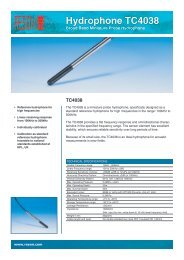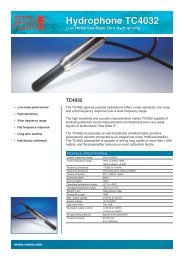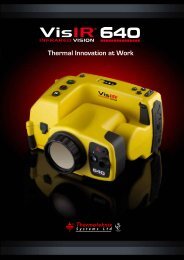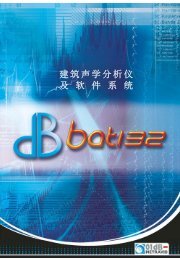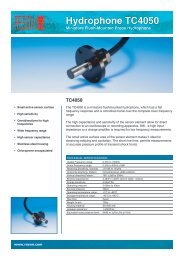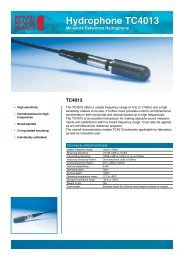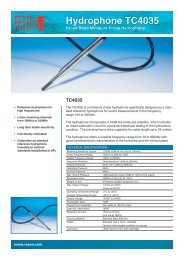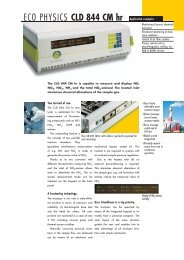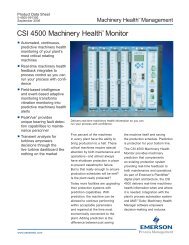Measurement of Refrigerant Emissions from Mobile A/C Systems
Measurement of Refrigerant Emissions from Mobile A/C Systems
Measurement of Refrigerant Emissions from Mobile A/C Systems
Create successful ePaper yourself
Turn your PDF publications into a flip-book with our unique Google optimized e-Paper software.
<strong>Measurement</strong> <strong>of</strong> <strong>Refrigerant</strong> <strong>Emissions</strong> <strong>from</strong> <strong>Mobile</strong> A/C <strong>Systems</strong><br />
Application Note<br />
The Problem<br />
The emission <strong>of</strong> man-made gases into the atmosphere has<br />
been associated with potential future adverse affects on the<br />
global climate.<br />
The industries involved in <strong>Mobile</strong> Air Conditioners are<br />
trying to reduce the overall emission <strong>of</strong> the frequently used<br />
coolant R134a or to introduce alternatives such as R152 or<br />
CO 2 .<br />
New methodologies for determining emission values <strong>of</strong><br />
R134a, R152 or CO 2 based upon gas analysis using Photoacoustic<br />
Spectroscopy (PAS) are being developed and<br />
tested by the industry.<br />
The Monitoring Need<br />
In order to evaluate refrigerant emission <strong>from</strong> mobile A/C<br />
systems or its components such as hoses, seals, O-rings or<br />
joints, the change in concentration <strong>of</strong> refrigerant versus<br />
time is measured in a closed testchamber <strong>of</strong> known volume.<br />
Such measurements have been done by Delphi Thermal<br />
& Interior Technical Center, Lockport, NY using the<br />
Photoacoustic Multi-gas Monitor 1314 in their laboratory<br />
for measurements <strong>of</strong> R134a, R152 and Carbon Dioxide.<br />
The PAS technique provides an accurate and rapid result<br />
with a high rate <strong>of</strong> repeatability, even at very low emission<br />
rates, such as those that occur at low to moderate temperatures.<br />
Unlike the traditional gravimetric method, gas<br />
analysis using PAS technology also allows separate measurements<br />
<strong>of</strong> hose permeation and coupling emission. To Delphi,<br />
the use <strong>of</strong> Photoacoustic Spectroscopy is a valuable<br />
and timesaving alternative.<br />
Figure 1. Test setup at Delphi Thermal & Interior Technical<br />
Center, Lockport, NY. The 1314 instrument is mounted in the<br />
top <strong>of</strong> the rack system to the right<br />
Photoacoustic Multi-gas Monitor 1314 fits in a 19” rack<br />
system and can either be operated manually or fully controlled<br />
over the RS-232 interface <strong>from</strong> a PC using the Monitoring<br />
S<strong>of</strong>tware 7304.<br />
INNOVA’s Solution<br />
The Photoacoustic Multi-gas Monitor 1314 is well suited<br />
for these types <strong>of</strong> laboratory measurements. The monitor is<br />
easily operated and can measure R134a, R152 and CO 2 in<br />
less that 20 seconds including compensation for water vapour.<br />
The advantage <strong>of</strong> photoacoustic infrared spectroscopy<br />
is high stability and repeatability with infrequent calibration<br />
(typical 1-2 times a year), linear response and low detection<br />
limit.<br />
The detection limit for the Photoacoustic Multi-gas Monitor<br />
1314 for the gases <strong>of</strong> interest are:<br />
• 0.01 ppm for Freon 134a<br />
• 0.002 ppm for Freon 152<br />
• 6 ppb for CO 2<br />
Figure 2. The Photoacoustic Multi-gas Monitor 1314
<strong>Measurement</strong> Results<br />
The following measurement results obtained by Delphi are<br />
all related to hose assemblies in the A/C system and the<br />
impact <strong>of</strong> different rubber materials and various types <strong>of</strong> oil<br />
(both vapor and liquid) in the R134a, where four different<br />
cases were studied:<br />
• Characteristics <strong>of</strong> hose permeation in response<br />
to the effect <strong>of</strong> oil in R134a<br />
• Condition <strong>of</strong> the hose material over time<br />
to reach steady state R134a emission<br />
• The relative contribution <strong>of</strong> hose permeation<br />
and coupling emission<br />
• Transient emission rates due to transient<br />
temperature and pressure conditions<br />
As shown below (Figure 3) three different leak rates are<br />
measured for their concentration vs. time using the Photoacoustic<br />
Multi-gas Monitor 1314.<br />
<strong>of</strong> the measurements with the Photoacoustic Multi-gas<br />
Monitor 1314 were focused on the correlation between the<br />
time and the emission rate <strong>from</strong> two different hose materials.<br />
The graphs in Figure 4 shows that an all-rubber hose<br />
requires at least 2½ days <strong>of</strong> conditioning at 90° C whereas<br />
barries hoses are stable after almost one day.<br />
Before the measurements the test chamber is calibrated<br />
with a known leak standard to determine its specific correlation<br />
factor. A leak standard <strong>of</strong> known rate is connected<br />
to the chamber to correlate the measured gas concentration<br />
(analyzer) versus time to the known leak rate. The derived<br />
correlation depends only upon the volume <strong>of</strong> the test<br />
chamber.<br />
Figure 3. Leak standard rates versus measured chamber concentration<br />
in ppm<br />
Figure 4. Two different tests on hose conditioning at 90°C.<br />
Innova AirTech Instruments has 45 international agents and distributors.<br />
For further information about our products or the name <strong>of</strong> your local contact,<br />
please call +(45) 44 20 01 00, or visit our homepage on the Internet<br />
at www.innova.dk.<br />
BO 0509-11<br />
Innova AirTech Instruments A/S<br />
Energivej 30, Tel.: (+45) 44 20 01 00 www.innova.dk<br />
DK-2750 Ballerup – Denmark Fax.: (+45) 44 20 01 01 E-mail: innova@innova.dk



